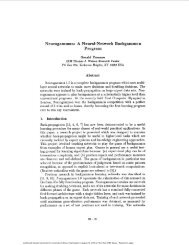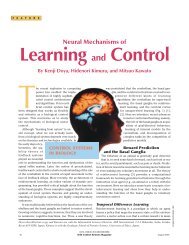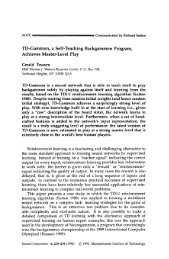998 <strong>IEEE</strong> TRANSACTIONS ON NEURAL NETWORKS, VOL. 8, NO. 5, SEPTEMBER 1997one-step cost (or its estimate) further referred to as the utility. Thus, some of the architectures we will consider involvetime-delay elements.The work of Barto et al. [14] and that of Watkins [12]both feature table-look up critic elements operating in discretedomains. These do not have any backpropagation path to theaction network, but do use the action signals to estimate autility or cost function. Barto et al. use an adaptive criticelement for a pole-balancing problem. Watkins [12] createdthe system known as Q-learning (the name is taken from hisnotation), explicitly based on dynamic programming. Werboshas championed a family of systems for approximatingdynamic programming [10]. His approach generalizes previouslysuggested designs for continuous domains. For example,Q-learning becomes a special case of an action-dependentheuristic dynamic programming (ADHDP; note the actiondependentprefix AD used hereafter) in his family of systems.Werbos goes beyond a critic approximating just the function. His systems called dual heuristic programming (DHP)[23], and globalized dual heuristic programming (GDHP) [22]are developed to approximate derivatives of the functionwith respect to the states, and both and its derivatives,respectively. It should be pointed out that these systems donot require exclusively neural-network implementations: anydifferentiable structure suffices as a building block of thesystems.This paper focuses on DHP and GDHP and their AD formsas advanced ACD’s, although we start by describing simpleACD’s: HDP and ADHDP (Section II). We provide two newmodifications of GDHP that are easier to implement than theoriginal GDHP design. We also introduce a new design calledADGDHP, which is currently the topmost in the hierarchy ofACD’s (Section II-D). We show that our designs of GDHP andADGDHP provide a unified framework to all ACD’s, i.e., anyACD can be obtained from them by a simple reconfiguration.We propose a general training procedure for adaptation of thenetworks of ACD in Section III. We contrast the advancedACD’s with the simple ACD’s in Section IV. In Section V,we discuss results of experimental work.II. DESIGN LADDERA. HDP and ADHDPHDP and its AD form have a critic network that estimatesthe function (cost-to-go) in the Bellman equation of dynamicprogramming, expressed as follows:where is a discount factor for finite horizon problems, and is the utility function or local cost. Thecritic is trained forward in time, which is of great importancefor real-time operation. The critic network tries to minimizethe following error measure over time:(1)(2)(3)(a)(b)Fig. 1. (a) <strong>Critic</strong> adaptation in ADHDP/HDP. This is the same critic networkin two consecutive moments in time. The critic’s output J(t +1) is necessaryin order to give us the training signal J(t +1)+U(t), which is the targetvalue for J(t). (b) Action adaptation. R is a vector of observables, A is acontrol vector. We use the constant @J=@J =1as the error signal in orderto train the action network to minimize J.where stands for either a vector of observables ofthe plant (or the states, if available) or a concatenation ofand a control (or action) vector . [The configuration fortraining the critic according to (3) is shown in Fig. 1(a).] Itshould be noted that, although both anddepend on weights of the critic, we do not account for thedependence of on weights while minimizingthe error (2). For example, in the case of minimization inthe least mean squares (LMS) we could write the followingexpression for the weights’ update:where is a positive learning rate. 1We seek to minimize or maximize in the immediate futurethereby optimizing the overall cost expressed as a sum of allover the horizon of the problem. To do so we needthe action network connected as shown in Fig. 1(b). To geta gradient of the cost function with respect to the action’sweights, we simply backpropagate (i.e., the constant1) through the network. This gives us andfor all inputs in the vector and all the action’s weights ,respectively.In HDP, action-critic connections are mediated by a model(or identification) network approximating dynamics of theplant. The model is needed when the problem’s temporalnature does not allow us to wait for subsequent time stepsto infer incremental costs. When we are able to wait for thisinformation or when sudden changes in plant dynamics preventus from using the same model, the action network is directlyconnected to the critic network. This is called ADHDP.B. DHP and ADDHPDHP and its AD form have a critic network that estimatesthe derivatives of with respect to the vector . The critic1 There exists a formal argument on whether to disregard the dependence ofJ[Y (t+1)] on WC [24] or, on the contrary, to account for such a dependence[25]. The former is our preferred way of adapting WC throughout the papersince the latter seems to be more applicable for finite-state Markov chains [8].(4)
PROKHOROV AND WUNSCH: ADAPTIVE CRITIC DESIGNS 999network learns minimization of the following error measureover time:(5)where(6)whereis a vector containing partial derivatives ofthe scalar with respect to the components of the vector. The critic network’s training is more complicated than inHDP since we need to take into account all relevant pathwaysof backpropagation as shown in Fig. 2, where the paths ofderivatives and adaptation of the critic are depicted by dashedlines.In DHP, application of the chain rule for derivatives yieldswhere , and , are thenumbers of outputs of the model and the action networks,respectively. By exploiting (7), each of components of thevector from (6) is determined byAction-dependent DHP (ADDHP) assumes direct connectionbetween the action and the critic networks. However,unlike ADHDP, we still need to have a model network becauseit is used for maintaining the pathways of backpropagation.ADDHP can be readily obtained from our design of ADGDHPto be discussed in the Section II-D.The action network is adapted in Fig. 2 by propagatingback through the model down to the action. Thegoal of such adaptation can be expressed as follows:For instance, we could write the following expression for theweights’ update when applying the LMS training algorithm:whereis a positive learning rate.(7)(8)(9)(10)Fig. 2. Adaptation in DHP. This is the same critic network shown in twoconsecutive moments in time. The discount factor is assumed to be equalto 1. Pathways of backpropagation are shown by dashed lines. Componentsof the vector (t +1) are propagated back from outputs R(t +1)of themodel network to its inputs R(t) and A(t), yielding the first term of (7)and the vector @J(t +1)=@A(t), respectively. The latter is propagated backfrom outputs A(t) of the action network to its inputs R(t), completing thesecond term in (7). This corresponds to the left-hand backpropagation pathway(thicker line) in the figure. Backpropagation of the vector @U(t)=@A(t)through the action network results in a vector with components computedas the last term of (8). This corresponds to the right-hand backpropagationpathway from the action network (thinner line) in the figure. Following (8),the summator produces the error vector E2(t) used to adapt the critic network.The action network is adapted as follows. The vector (t +1)is propagatedback through the model network to the action network, and the resultingvector is added to @U(t)=@A(t). Then an incremental adaptation of the actionnetwork is invoked with the goal (9).C. GDHPGDHP minimizes the error with respect to both and itsderivatives. While it is more complex to do this simultaneously,the resulting behavior is expected to be superior. Wedescribe three ways to do GDHP (Figs. 3–5). The first of thesewas proposed by Werbos in [22]. The other two are our ownnew suggestions.Training the critic network in GDHP utilizes an errormeasure which is a combination of the error measures of HDPand DHP (2) and (5). This results in the following LMS updaterule for the critic’s weights:(11)where is given in (8), and and are positive learningrates.A major source of additional complexity in GDHPis the necessity of computing second-order derivatives. To get the adaptation signal-2 [the secondterm in (11)] in the originally proposed GDHP (Fig. 3), we firstneed to create a network dual to our critic network. The dualnetwork inputs the output and states of all hidden neurons ofthe critic. Its output,, is exactly what one wouldget performing backpropagation from the critic’s output toits input . Here we need these computations performedseparately and explicitly shown as a dual network. Then we









